DET Unit 417: Comprehensive Report on Inclusive Practices
VerifiedAdded on 2021/07/05
|18
|4629
|916
Report
AI Summary
This report, addressing Unit 417 on Inclusive Practices, delves into the multifaceted aspects of creating an inclusive learning environment. It begins by reviewing the impact of social, personal, and cultural factors on learning, emphasizing the importance of considering age, confidence, educational background, financial situations, and cultural and religious attitudes. The report then explores cognitive, sensitive, and physical abilities in the learning process, highlighting the significance of cognitive skills like visual consciousness and physical abilities. A significant portion of the report summarizes relevant policy and regulatory frameworks, notably the Equality Act 2010, and explains how these frameworks influence both organizational and individual practices. The report also outlines the trainee teacher's roles and responsibilities in inclusive practices, emphasizing the importance of collaboration with other professionals and identifying referral points to meet diverse learning needs. Furthermore, the report reviews the benefits of an inclusive learning environment and strategies for effective liaison between professionals. Finally, the report concludes with a reflective evidence section, including a SWOT analysis and plans for promoting equality, diversity, and inclusion, as well as identifying opportunities for skill improvement in inclusive practices. This report is a valuable resource for students on Desklib, providing insights into creating and maintaining inclusive educational environments.
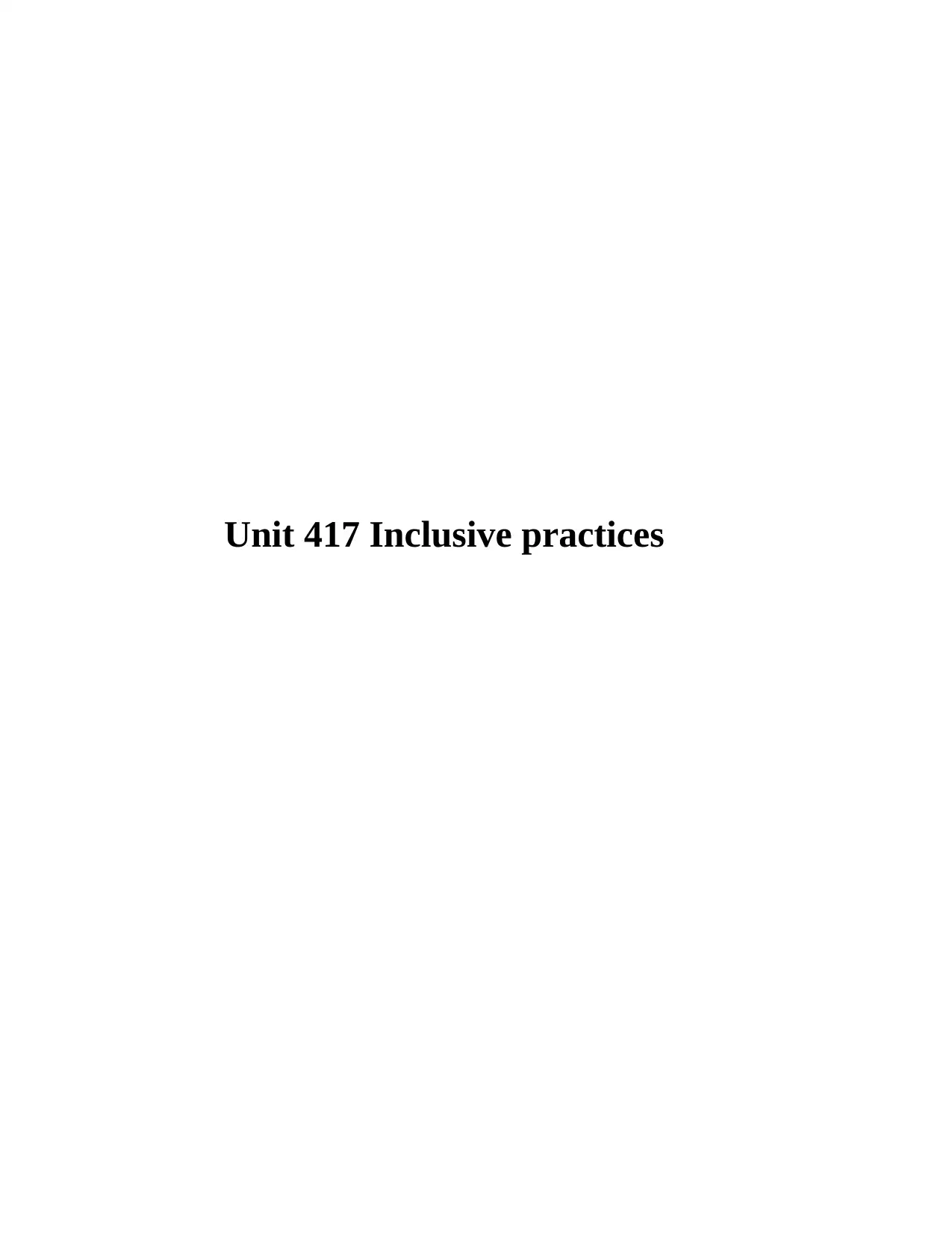
Unit 417 Inclusive practices
Paraphrase This Document
Need a fresh take? Get an instant paraphrase of this document with our AI Paraphraser
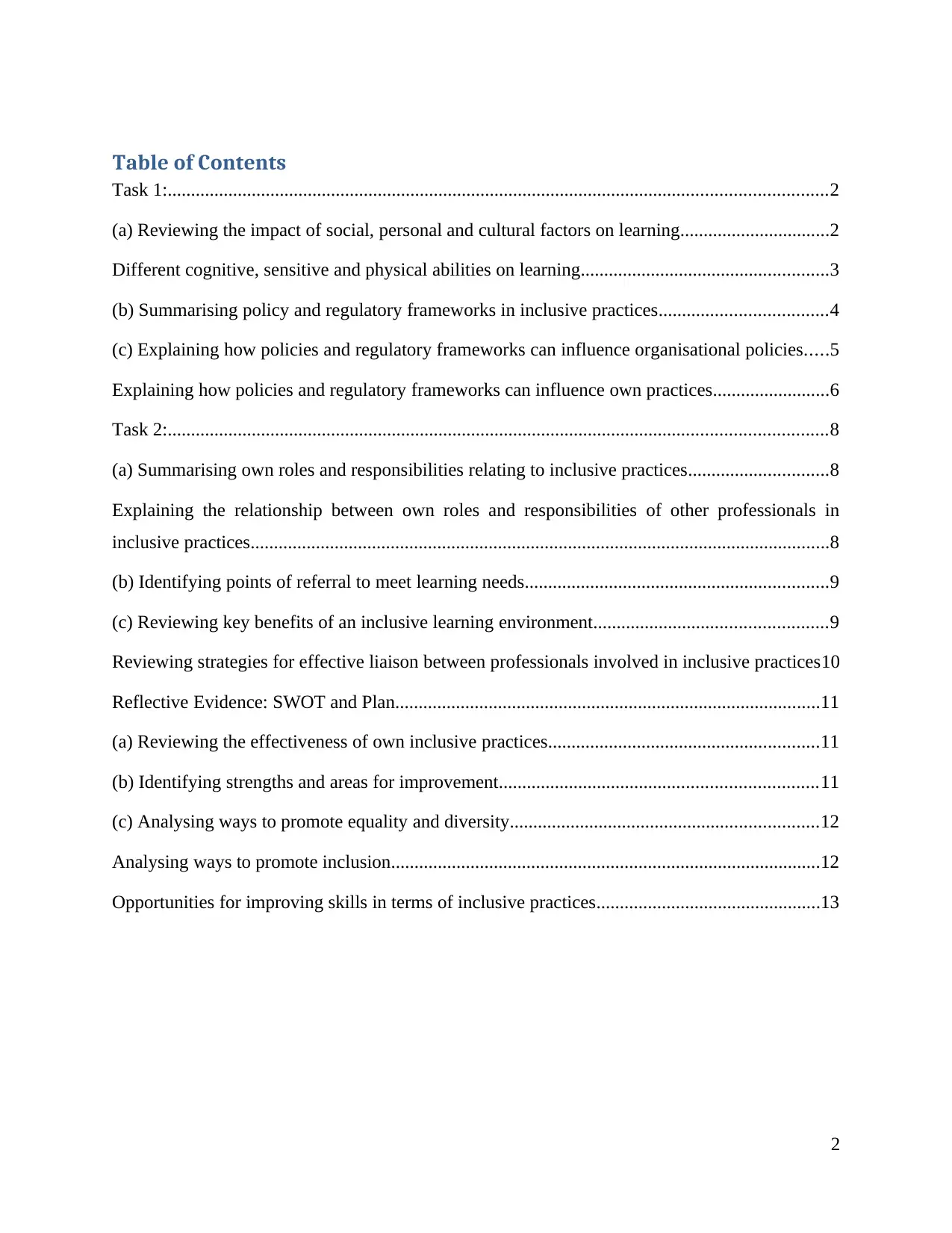
Table of Contents
Task 1:.............................................................................................................................................2
(a) Reviewing the impact of social, personal and cultural factors on learning................................2
Different cognitive, sensitive and physical abilities on learning.....................................................3
(b) Summarising policy and regulatory frameworks in inclusive practices....................................4
(c) Explaining how policies and regulatory frameworks can influence organisational policies.....5
Explaining how policies and regulatory frameworks can influence own practices.........................6
Task 2:.............................................................................................................................................8
(a) Summarising own roles and responsibilities relating to inclusive practices..............................8
Explaining the relationship between own roles and responsibilities of other professionals in
inclusive practices............................................................................................................................8
(b) Identifying points of referral to meet learning needs.................................................................9
(c) Reviewing key benefits of an inclusive learning environment..................................................9
Reviewing strategies for effective liaison between professionals involved in inclusive practices10
Reflective Evidence: SWOT and Plan...........................................................................................11
(a) Reviewing the effectiveness of own inclusive practices..........................................................11
(b) Identifying strengths and areas for improvement....................................................................11
(c) Analysing ways to promote equality and diversity..................................................................12
Analysing ways to promote inclusion............................................................................................12
Opportunities for improving skills in terms of inclusive practices................................................13
2
Task 1:.............................................................................................................................................2
(a) Reviewing the impact of social, personal and cultural factors on learning................................2
Different cognitive, sensitive and physical abilities on learning.....................................................3
(b) Summarising policy and regulatory frameworks in inclusive practices....................................4
(c) Explaining how policies and regulatory frameworks can influence organisational policies.....5
Explaining how policies and regulatory frameworks can influence own practices.........................6
Task 2:.............................................................................................................................................8
(a) Summarising own roles and responsibilities relating to inclusive practices..............................8
Explaining the relationship between own roles and responsibilities of other professionals in
inclusive practices............................................................................................................................8
(b) Identifying points of referral to meet learning needs.................................................................9
(c) Reviewing key benefits of an inclusive learning environment..................................................9
Reviewing strategies for effective liaison between professionals involved in inclusive practices10
Reflective Evidence: SWOT and Plan...........................................................................................11
(a) Reviewing the effectiveness of own inclusive practices..........................................................11
(b) Identifying strengths and areas for improvement....................................................................11
(c) Analysing ways to promote equality and diversity..................................................................12
Analysing ways to promote inclusion............................................................................................12
Opportunities for improving skills in terms of inclusive practices................................................13
2
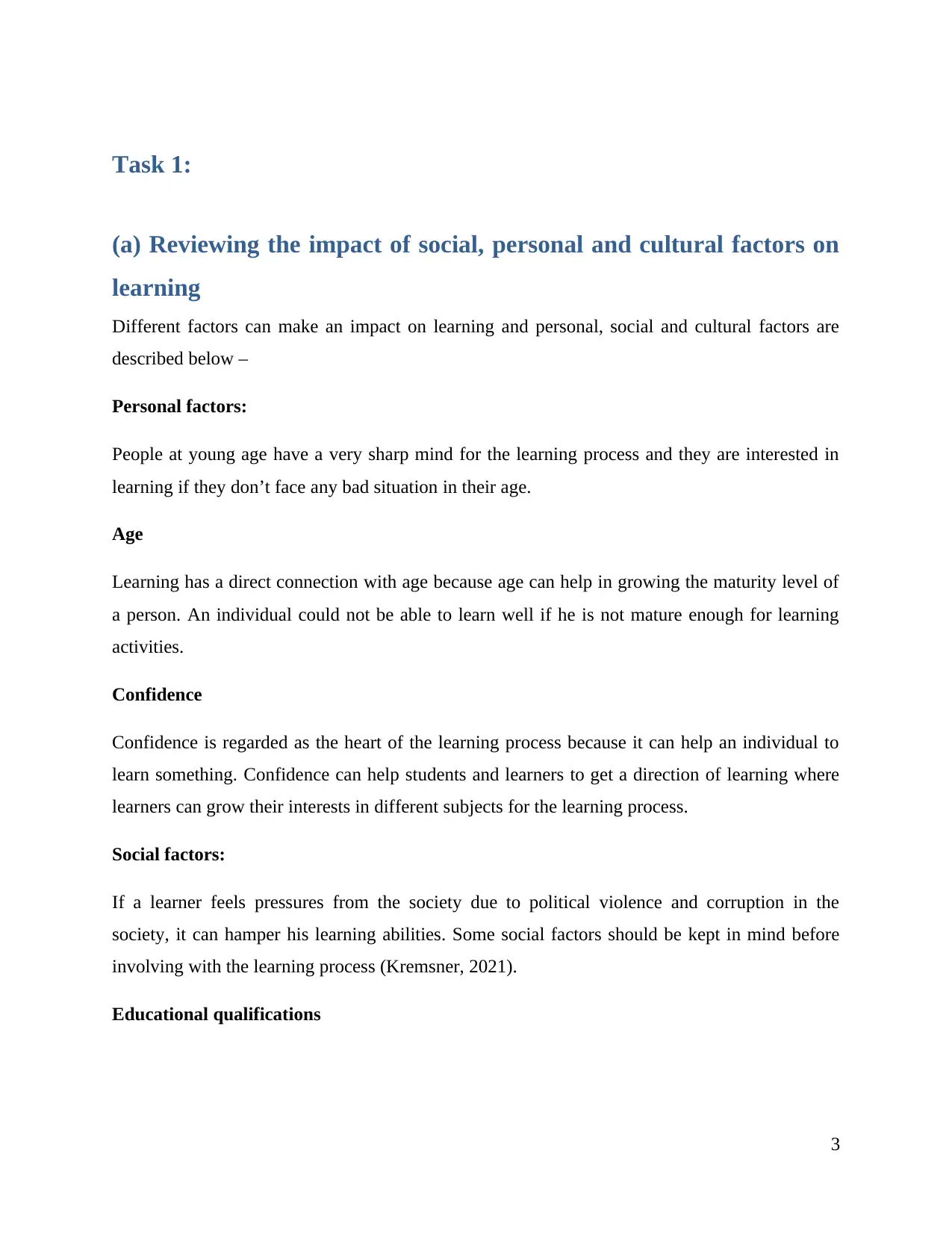
Task 1:
(a) Reviewing the impact of social, personal and cultural factors on
learning
Different factors can make an impact on learning and personal, social and cultural factors are
described below –
Personal factors:
People at young age have a very sharp mind for the learning process and they are interested in
learning if they don’t face any bad situation in their age.
Age
Learning has a direct connection with age because age can help in growing the maturity level of
a person. An individual could not be able to learn well if he is not mature enough for learning
activities.
Confidence
Confidence is regarded as the heart of the learning process because it can help an individual to
learn something. Confidence can help students and learners to get a direction of learning where
learners can grow their interests in different subjects for the learning process.
Social factors:
If a learner feels pressures from the society due to political violence and corruption in the
society, it can hamper his learning abilities. Some social factors should be kept in mind before
involving with the learning process (Kremsner, 2021).
Educational qualifications
3
(a) Reviewing the impact of social, personal and cultural factors on
learning
Different factors can make an impact on learning and personal, social and cultural factors are
described below –
Personal factors:
People at young age have a very sharp mind for the learning process and they are interested in
learning if they don’t face any bad situation in their age.
Age
Learning has a direct connection with age because age can help in growing the maturity level of
a person. An individual could not be able to learn well if he is not mature enough for learning
activities.
Confidence
Confidence is regarded as the heart of the learning process because it can help an individual to
learn something. Confidence can help students and learners to get a direction of learning where
learners can grow their interests in different subjects for the learning process.
Social factors:
If a learner feels pressures from the society due to political violence and corruption in the
society, it can hamper his learning abilities. Some social factors should be kept in mind before
involving with the learning process (Kremsner, 2021).
Educational qualifications
3
⊘ This is a preview!⊘
Do you want full access?
Subscribe today to unlock all pages.

Trusted by 1+ million students worldwide
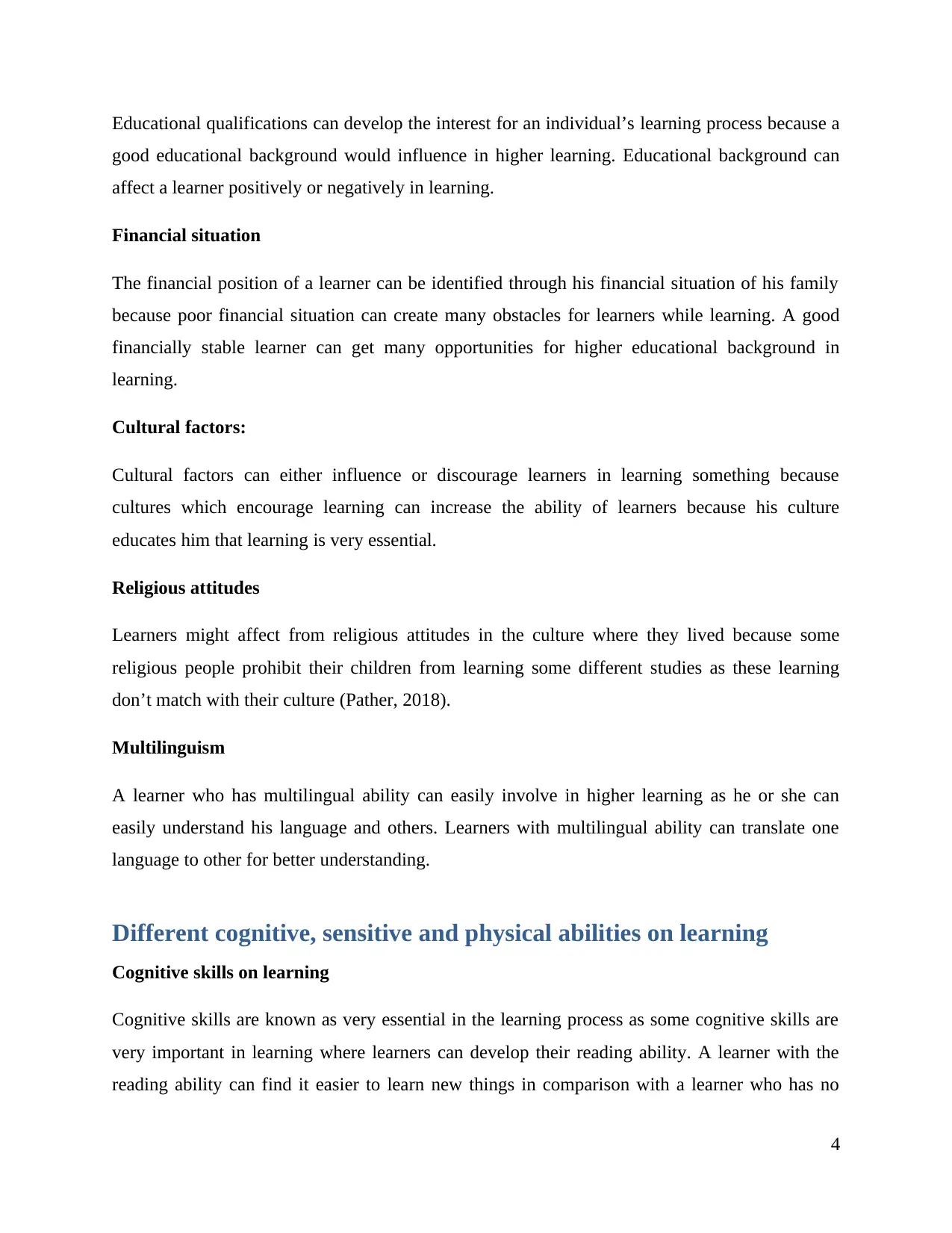
Educational qualifications can develop the interest for an individual’s learning process because a
good educational background would influence in higher learning. Educational background can
affect a learner positively or negatively in learning.
Financial situation
The financial position of a learner can be identified through his financial situation of his family
because poor financial situation can create many obstacles for learners while learning. A good
financially stable learner can get many opportunities for higher educational background in
learning.
Cultural factors:
Cultural factors can either influence or discourage learners in learning something because
cultures which encourage learning can increase the ability of learners because his culture
educates him that learning is very essential.
Religious attitudes
Learners might affect from religious attitudes in the culture where they lived because some
religious people prohibit their children from learning some different studies as these learning
don’t match with their culture (Pather, 2018).
Multilinguism
A learner who has multilingual ability can easily involve in higher learning as he or she can
easily understand his language and others. Learners with multilingual ability can translate one
language to other for better understanding.
Different cognitive, sensitive and physical abilities on learning
Cognitive skills on learning
Cognitive skills are known as very essential in the learning process as some cognitive skills are
very important in learning where learners can develop their reading ability. A learner with the
reading ability can find it easier to learn new things in comparison with a learner who has no
4
good educational background would influence in higher learning. Educational background can
affect a learner positively or negatively in learning.
Financial situation
The financial position of a learner can be identified through his financial situation of his family
because poor financial situation can create many obstacles for learners while learning. A good
financially stable learner can get many opportunities for higher educational background in
learning.
Cultural factors:
Cultural factors can either influence or discourage learners in learning something because
cultures which encourage learning can increase the ability of learners because his culture
educates him that learning is very essential.
Religious attitudes
Learners might affect from religious attitudes in the culture where they lived because some
religious people prohibit their children from learning some different studies as these learning
don’t match with their culture (Pather, 2018).
Multilinguism
A learner who has multilingual ability can easily involve in higher learning as he or she can
easily understand his language and others. Learners with multilingual ability can translate one
language to other for better understanding.
Different cognitive, sensitive and physical abilities on learning
Cognitive skills on learning
Cognitive skills are known as very essential in the learning process as some cognitive skills are
very important in learning where learners can develop their reading ability. A learner with the
reading ability can find it easier to learn new things in comparison with a learner who has no
4
Paraphrase This Document
Need a fresh take? Get an instant paraphrase of this document with our AI Paraphraser
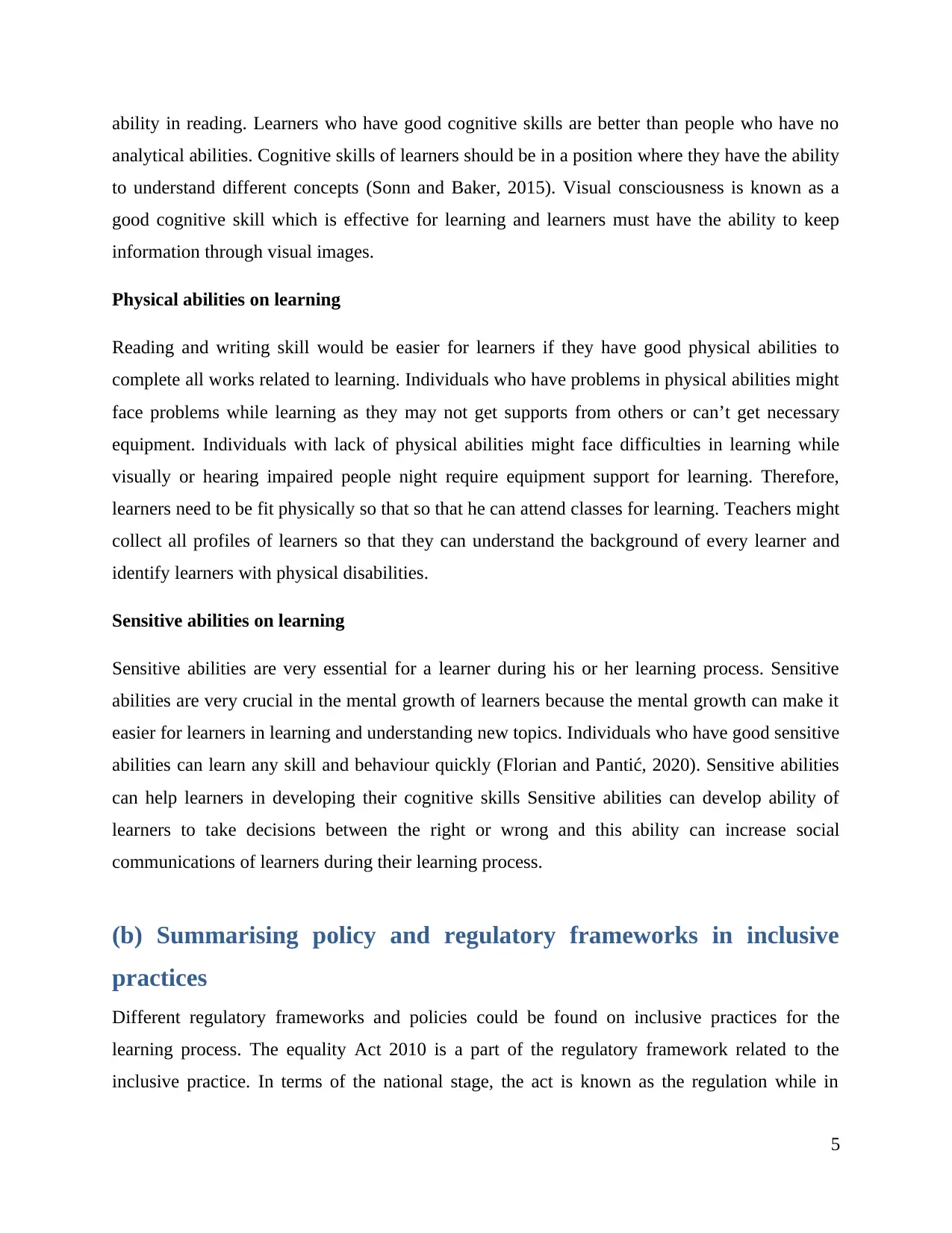
ability in reading. Learners who have good cognitive skills are better than people who have no
analytical abilities. Cognitive skills of learners should be in a position where they have the ability
to understand different concepts (Sonn and Baker, 2015). Visual consciousness is known as a
good cognitive skill which is effective for learning and learners must have the ability to keep
information through visual images.
Physical abilities on learning
Reading and writing skill would be easier for learners if they have good physical abilities to
complete all works related to learning. Individuals who have problems in physical abilities might
face problems while learning as they may not get supports from others or can’t get necessary
equipment. Individuals with lack of physical abilities might face difficulties in learning while
visually or hearing impaired people night require equipment support for learning. Therefore,
learners need to be fit physically so that so that he can attend classes for learning. Teachers might
collect all profiles of learners so that they can understand the background of every learner and
identify learners with physical disabilities.
Sensitive abilities on learning
Sensitive abilities are very essential for a learner during his or her learning process. Sensitive
abilities are very crucial in the mental growth of learners because the mental growth can make it
easier for learners in learning and understanding new topics. Individuals who have good sensitive
abilities can learn any skill and behaviour quickly (Florian and Pantić, 2020). Sensitive abilities
can help learners in developing their cognitive skills Sensitive abilities can develop ability of
learners to take decisions between the right or wrong and this ability can increase social
communications of learners during their learning process.
(b) Summarising policy and regulatory frameworks in inclusive
practices
Different regulatory frameworks and policies could be found on inclusive practices for the
learning process. The equality Act 2010 is a part of the regulatory framework related to the
inclusive practice. In terms of the national stage, the act is known as the regulation while in
5
analytical abilities. Cognitive skills of learners should be in a position where they have the ability
to understand different concepts (Sonn and Baker, 2015). Visual consciousness is known as a
good cognitive skill which is effective for learning and learners must have the ability to keep
information through visual images.
Physical abilities on learning
Reading and writing skill would be easier for learners if they have good physical abilities to
complete all works related to learning. Individuals who have problems in physical abilities might
face problems while learning as they may not get supports from others or can’t get necessary
equipment. Individuals with lack of physical abilities might face difficulties in learning while
visually or hearing impaired people night require equipment support for learning. Therefore,
learners need to be fit physically so that so that he can attend classes for learning. Teachers might
collect all profiles of learners so that they can understand the background of every learner and
identify learners with physical disabilities.
Sensitive abilities on learning
Sensitive abilities are very essential for a learner during his or her learning process. Sensitive
abilities are very crucial in the mental growth of learners because the mental growth can make it
easier for learners in learning and understanding new topics. Individuals who have good sensitive
abilities can learn any skill and behaviour quickly (Florian and Pantić, 2020). Sensitive abilities
can help learners in developing their cognitive skills Sensitive abilities can develop ability of
learners to take decisions between the right or wrong and this ability can increase social
communications of learners during their learning process.
(b) Summarising policy and regulatory frameworks in inclusive
practices
Different regulatory frameworks and policies could be found on inclusive practices for the
learning process. The equality Act 2010 is a part of the regulatory framework related to the
inclusive practice. In terms of the national stage, the act is known as the regulation while in
5
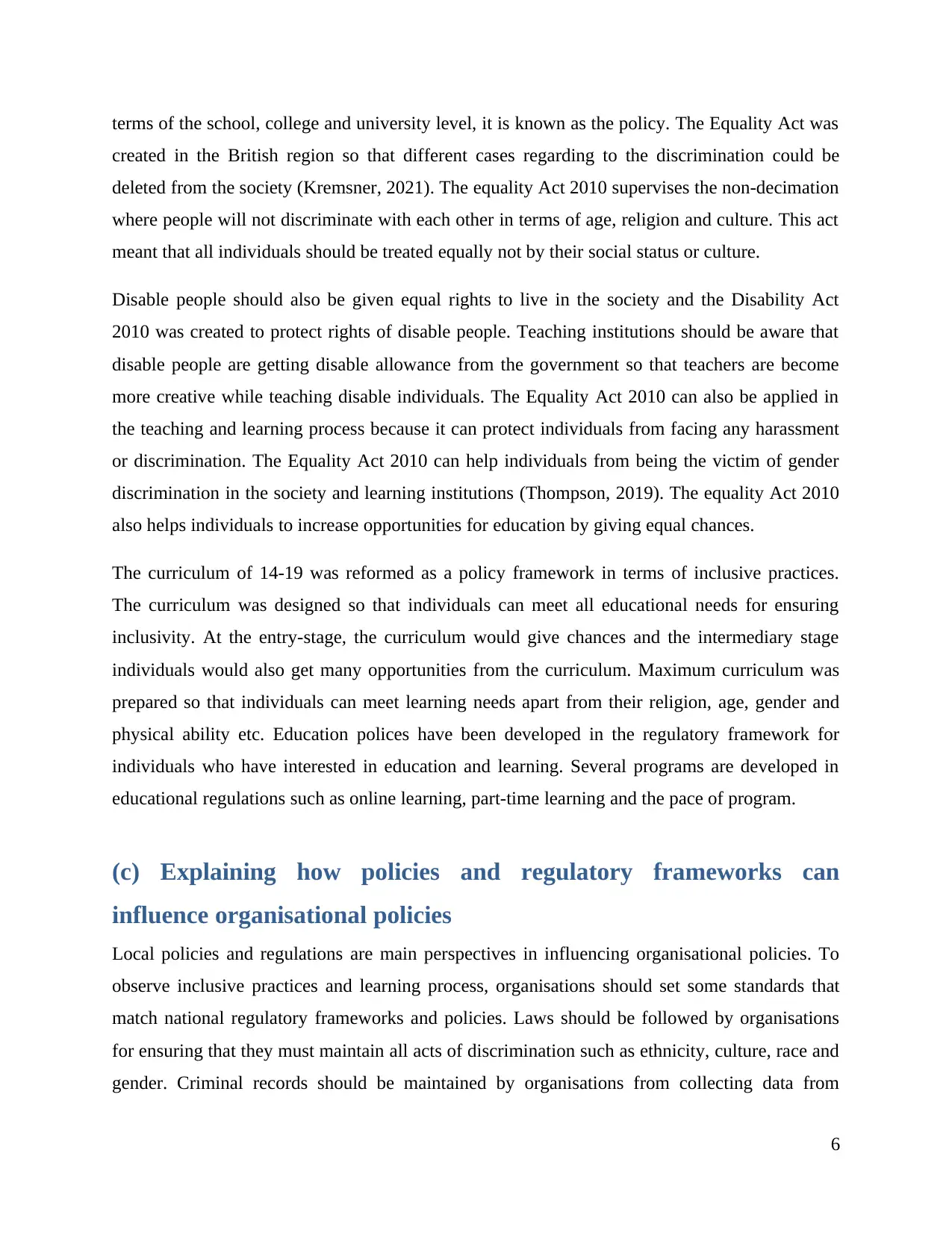
terms of the school, college and university level, it is known as the policy. The Equality Act was
created in the British region so that different cases regarding to the discrimination could be
deleted from the society (Kremsner, 2021). The equality Act 2010 supervises the non-decimation
where people will not discriminate with each other in terms of age, religion and culture. This act
meant that all individuals should be treated equally not by their social status or culture.
Disable people should also be given equal rights to live in the society and the Disability Act
2010 was created to protect rights of disable people. Teaching institutions should be aware that
disable people are getting disable allowance from the government so that teachers are become
more creative while teaching disable individuals. The Equality Act 2010 can also be applied in
the teaching and learning process because it can protect individuals from facing any harassment
or discrimination. The Equality Act 2010 can help individuals from being the victim of gender
discrimination in the society and learning institutions (Thompson, 2019). The equality Act 2010
also helps individuals to increase opportunities for education by giving equal chances.
The curriculum of 14-19 was reformed as a policy framework in terms of inclusive practices.
The curriculum was designed so that individuals can meet all educational needs for ensuring
inclusivity. At the entry-stage, the curriculum would give chances and the intermediary stage
individuals would also get many opportunities from the curriculum. Maximum curriculum was
prepared so that individuals can meet learning needs apart from their religion, age, gender and
physical ability etc. Education polices have been developed in the regulatory framework for
individuals who have interested in education and learning. Several programs are developed in
educational regulations such as online learning, part-time learning and the pace of program.
(c) Explaining how policies and regulatory frameworks can
influence organisational policies
Local policies and regulations are main perspectives in influencing organisational policies. To
observe inclusive practices and learning process, organisations should set some standards that
match national regulatory frameworks and policies. Laws should be followed by organisations
for ensuring that they must maintain all acts of discrimination such as ethnicity, culture, race and
gender. Criminal records should be maintained by organisations from collecting data from
6
created in the British region so that different cases regarding to the discrimination could be
deleted from the society (Kremsner, 2021). The equality Act 2010 supervises the non-decimation
where people will not discriminate with each other in terms of age, religion and culture. This act
meant that all individuals should be treated equally not by their social status or culture.
Disable people should also be given equal rights to live in the society and the Disability Act
2010 was created to protect rights of disable people. Teaching institutions should be aware that
disable people are getting disable allowance from the government so that teachers are become
more creative while teaching disable individuals. The Equality Act 2010 can also be applied in
the teaching and learning process because it can protect individuals from facing any harassment
or discrimination. The Equality Act 2010 can help individuals from being the victim of gender
discrimination in the society and learning institutions (Thompson, 2019). The equality Act 2010
also helps individuals to increase opportunities for education by giving equal chances.
The curriculum of 14-19 was reformed as a policy framework in terms of inclusive practices.
The curriculum was designed so that individuals can meet all educational needs for ensuring
inclusivity. At the entry-stage, the curriculum would give chances and the intermediary stage
individuals would also get many opportunities from the curriculum. Maximum curriculum was
prepared so that individuals can meet learning needs apart from their religion, age, gender and
physical ability etc. Education polices have been developed in the regulatory framework for
individuals who have interested in education and learning. Several programs are developed in
educational regulations such as online learning, part-time learning and the pace of program.
(c) Explaining how policies and regulatory frameworks can
influence organisational policies
Local policies and regulations are main perspectives in influencing organisational policies. To
observe inclusive practices and learning process, organisations should set some standards that
match national regulatory frameworks and policies. Laws should be followed by organisations
for ensuring that they must maintain all acts of discrimination such as ethnicity, culture, race and
gender. Criminal records should be maintained by organisations from collecting data from
6
⊘ This is a preview!⊘
Do you want full access?
Subscribe today to unlock all pages.

Trusted by 1+ million students worldwide
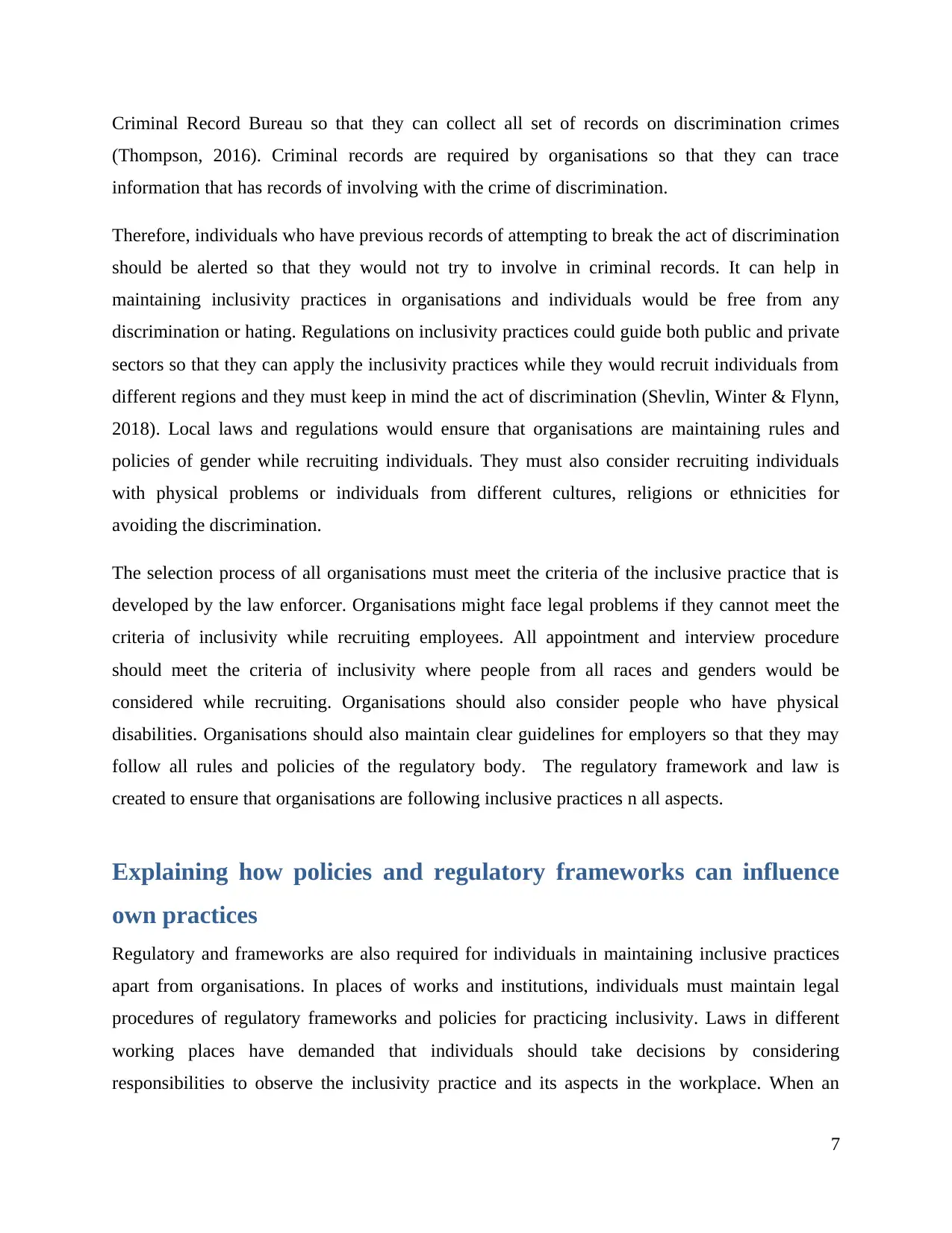
Criminal Record Bureau so that they can collect all set of records on discrimination crimes
(Thompson, 2016). Criminal records are required by organisations so that they can trace
information that has records of involving with the crime of discrimination.
Therefore, individuals who have previous records of attempting to break the act of discrimination
should be alerted so that they would not try to involve in criminal records. It can help in
maintaining inclusivity practices in organisations and individuals would be free from any
discrimination or hating. Regulations on inclusivity practices could guide both public and private
sectors so that they can apply the inclusivity practices while they would recruit individuals from
different regions and they must keep in mind the act of discrimination (Shevlin, Winter & Flynn,
2018). Local laws and regulations would ensure that organisations are maintaining rules and
policies of gender while recruiting individuals. They must also consider recruiting individuals
with physical problems or individuals from different cultures, religions or ethnicities for
avoiding the discrimination.
The selection process of all organisations must meet the criteria of the inclusive practice that is
developed by the law enforcer. Organisations might face legal problems if they cannot meet the
criteria of inclusivity while recruiting employees. All appointment and interview procedure
should meet the criteria of inclusivity where people from all races and genders would be
considered while recruiting. Organisations should also consider people who have physical
disabilities. Organisations should also maintain clear guidelines for employers so that they may
follow all rules and policies of the regulatory body. The regulatory framework and law is
created to ensure that organisations are following inclusive practices n all aspects.
Explaining how policies and regulatory frameworks can influence
own practices
Regulatory and frameworks are also required for individuals in maintaining inclusive practices
apart from organisations. In places of works and institutions, individuals must maintain legal
procedures of regulatory frameworks and policies for practicing inclusivity. Laws in different
working places have demanded that individuals should take decisions by considering
responsibilities to observe the inclusivity practice and its aspects in the workplace. When an
7
(Thompson, 2016). Criminal records are required by organisations so that they can trace
information that has records of involving with the crime of discrimination.
Therefore, individuals who have previous records of attempting to break the act of discrimination
should be alerted so that they would not try to involve in criminal records. It can help in
maintaining inclusivity practices in organisations and individuals would be free from any
discrimination or hating. Regulations on inclusivity practices could guide both public and private
sectors so that they can apply the inclusivity practices while they would recruit individuals from
different regions and they must keep in mind the act of discrimination (Shevlin, Winter & Flynn,
2018). Local laws and regulations would ensure that organisations are maintaining rules and
policies of gender while recruiting individuals. They must also consider recruiting individuals
with physical problems or individuals from different cultures, religions or ethnicities for
avoiding the discrimination.
The selection process of all organisations must meet the criteria of the inclusive practice that is
developed by the law enforcer. Organisations might face legal problems if they cannot meet the
criteria of inclusivity while recruiting employees. All appointment and interview procedure
should meet the criteria of inclusivity where people from all races and genders would be
considered while recruiting. Organisations should also consider people who have physical
disabilities. Organisations should also maintain clear guidelines for employers so that they may
follow all rules and policies of the regulatory body. The regulatory framework and law is
created to ensure that organisations are following inclusive practices n all aspects.
Explaining how policies and regulatory frameworks can influence
own practices
Regulatory and frameworks are also required for individuals in maintaining inclusive practices
apart from organisations. In places of works and institutions, individuals must maintain legal
procedures of regulatory frameworks and policies for practicing inclusivity. Laws in different
working places have demanded that individuals should take decisions by considering
responsibilities to observe the inclusivity practice and its aspects in the workplace. When an
7
Paraphrase This Document
Need a fresh take? Get an instant paraphrase of this document with our AI Paraphraser
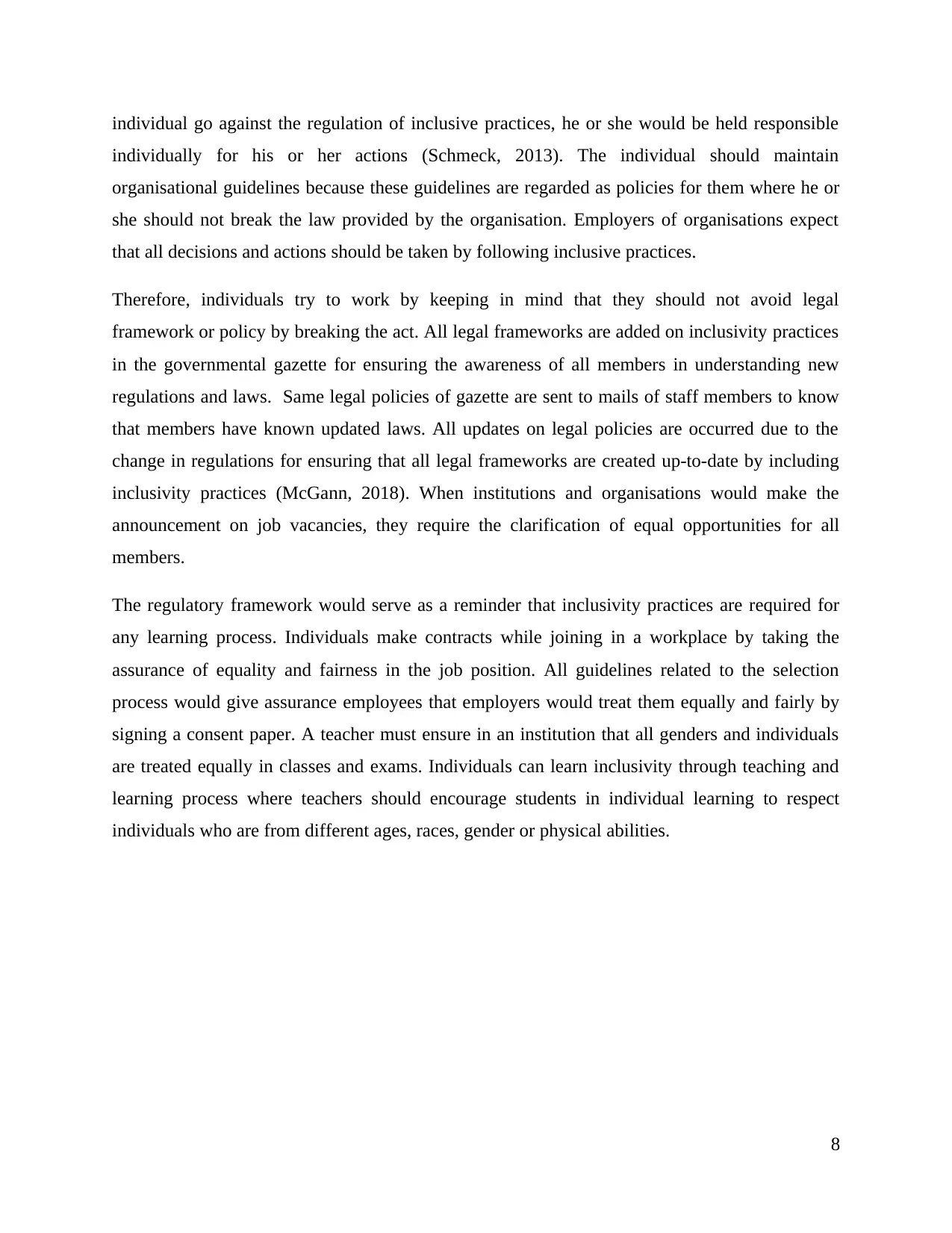
individual go against the regulation of inclusive practices, he or she would be held responsible
individually for his or her actions (Schmeck, 2013). The individual should maintain
organisational guidelines because these guidelines are regarded as policies for them where he or
she should not break the law provided by the organisation. Employers of organisations expect
that all decisions and actions should be taken by following inclusive practices.
Therefore, individuals try to work by keeping in mind that they should not avoid legal
framework or policy by breaking the act. All legal frameworks are added on inclusivity practices
in the governmental gazette for ensuring the awareness of all members in understanding new
regulations and laws. Same legal policies of gazette are sent to mails of staff members to know
that members have known updated laws. All updates on legal policies are occurred due to the
change in regulations for ensuring that all legal frameworks are created up-to-date by including
inclusivity practices (McGann, 2018). When institutions and organisations would make the
announcement on job vacancies, they require the clarification of equal opportunities for all
members.
The regulatory framework would serve as a reminder that inclusivity practices are required for
any learning process. Individuals make contracts while joining in a workplace by taking the
assurance of equality and fairness in the job position. All guidelines related to the selection
process would give assurance employees that employers would treat them equally and fairly by
signing a consent paper. A teacher must ensure in an institution that all genders and individuals
are treated equally in classes and exams. Individuals can learn inclusivity through teaching and
learning process where teachers should encourage students in individual learning to respect
individuals who are from different ages, races, gender or physical abilities.
8
individually for his or her actions (Schmeck, 2013). The individual should maintain
organisational guidelines because these guidelines are regarded as policies for them where he or
she should not break the law provided by the organisation. Employers of organisations expect
that all decisions and actions should be taken by following inclusive practices.
Therefore, individuals try to work by keeping in mind that they should not avoid legal
framework or policy by breaking the act. All legal frameworks are added on inclusivity practices
in the governmental gazette for ensuring the awareness of all members in understanding new
regulations and laws. Same legal policies of gazette are sent to mails of staff members to know
that members have known updated laws. All updates on legal policies are occurred due to the
change in regulations for ensuring that all legal frameworks are created up-to-date by including
inclusivity practices (McGann, 2018). When institutions and organisations would make the
announcement on job vacancies, they require the clarification of equal opportunities for all
members.
The regulatory framework would serve as a reminder that inclusivity practices are required for
any learning process. Individuals make contracts while joining in a workplace by taking the
assurance of equality and fairness in the job position. All guidelines related to the selection
process would give assurance employees that employers would treat them equally and fairly by
signing a consent paper. A teacher must ensure in an institution that all genders and individuals
are treated equally in classes and exams. Individuals can learn inclusivity through teaching and
learning process where teachers should encourage students in individual learning to respect
individuals who are from different ages, races, gender or physical abilities.
8
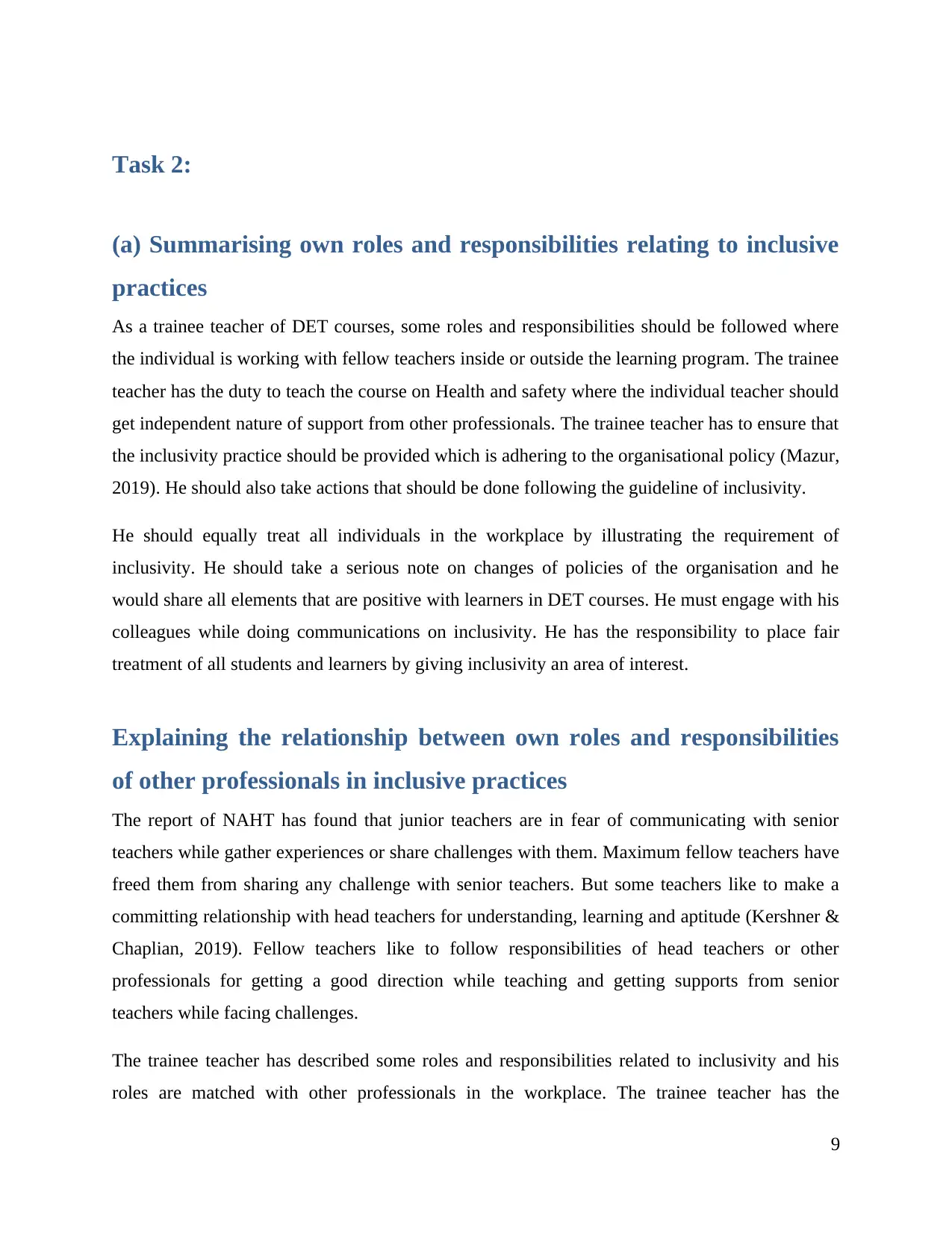
Task 2:
(a) Summarising own roles and responsibilities relating to inclusive
practices
As a trainee teacher of DET courses, some roles and responsibilities should be followed where
the individual is working with fellow teachers inside or outside the learning program. The trainee
teacher has the duty to teach the course on Health and safety where the individual teacher should
get independent nature of support from other professionals. The trainee teacher has to ensure that
the inclusivity practice should be provided which is adhering to the organisational policy (Mazur,
2019). He should also take actions that should be done following the guideline of inclusivity.
He should equally treat all individuals in the workplace by illustrating the requirement of
inclusivity. He should take a serious note on changes of policies of the organisation and he
would share all elements that are positive with learners in DET courses. He must engage with his
colleagues while doing communications on inclusivity. He has the responsibility to place fair
treatment of all students and learners by giving inclusivity an area of interest.
Explaining the relationship between own roles and responsibilities
of other professionals in inclusive practices
The report of NAHT has found that junior teachers are in fear of communicating with senior
teachers while gather experiences or share challenges with them. Maximum fellow teachers have
freed them from sharing any challenge with senior teachers. But some teachers like to make a
committing relationship with head teachers for understanding, learning and aptitude (Kershner &
Chaplian, 2019). Fellow teachers like to follow responsibilities of head teachers or other
professionals for getting a good direction while teaching and getting supports from senior
teachers while facing challenges.
The trainee teacher has described some roles and responsibilities related to inclusivity and his
roles are matched with other professionals in the workplace. The trainee teacher has the
9
(a) Summarising own roles and responsibilities relating to inclusive
practices
As a trainee teacher of DET courses, some roles and responsibilities should be followed where
the individual is working with fellow teachers inside or outside the learning program. The trainee
teacher has the duty to teach the course on Health and safety where the individual teacher should
get independent nature of support from other professionals. The trainee teacher has to ensure that
the inclusivity practice should be provided which is adhering to the organisational policy (Mazur,
2019). He should also take actions that should be done following the guideline of inclusivity.
He should equally treat all individuals in the workplace by illustrating the requirement of
inclusivity. He should take a serious note on changes of policies of the organisation and he
would share all elements that are positive with learners in DET courses. He must engage with his
colleagues while doing communications on inclusivity. He has the responsibility to place fair
treatment of all students and learners by giving inclusivity an area of interest.
Explaining the relationship between own roles and responsibilities
of other professionals in inclusive practices
The report of NAHT has found that junior teachers are in fear of communicating with senior
teachers while gather experiences or share challenges with them. Maximum fellow teachers have
freed them from sharing any challenge with senior teachers. But some teachers like to make a
committing relationship with head teachers for understanding, learning and aptitude (Kershner &
Chaplian, 2019). Fellow teachers like to follow responsibilities of head teachers or other
professionals for getting a good direction while teaching and getting supports from senior
teachers while facing challenges.
The trainee teacher has described some roles and responsibilities related to inclusivity and his
roles are matched with other professionals in the workplace. The trainee teacher has the
9
⊘ This is a preview!⊘
Do you want full access?
Subscribe today to unlock all pages.

Trusted by 1+ million students worldwide
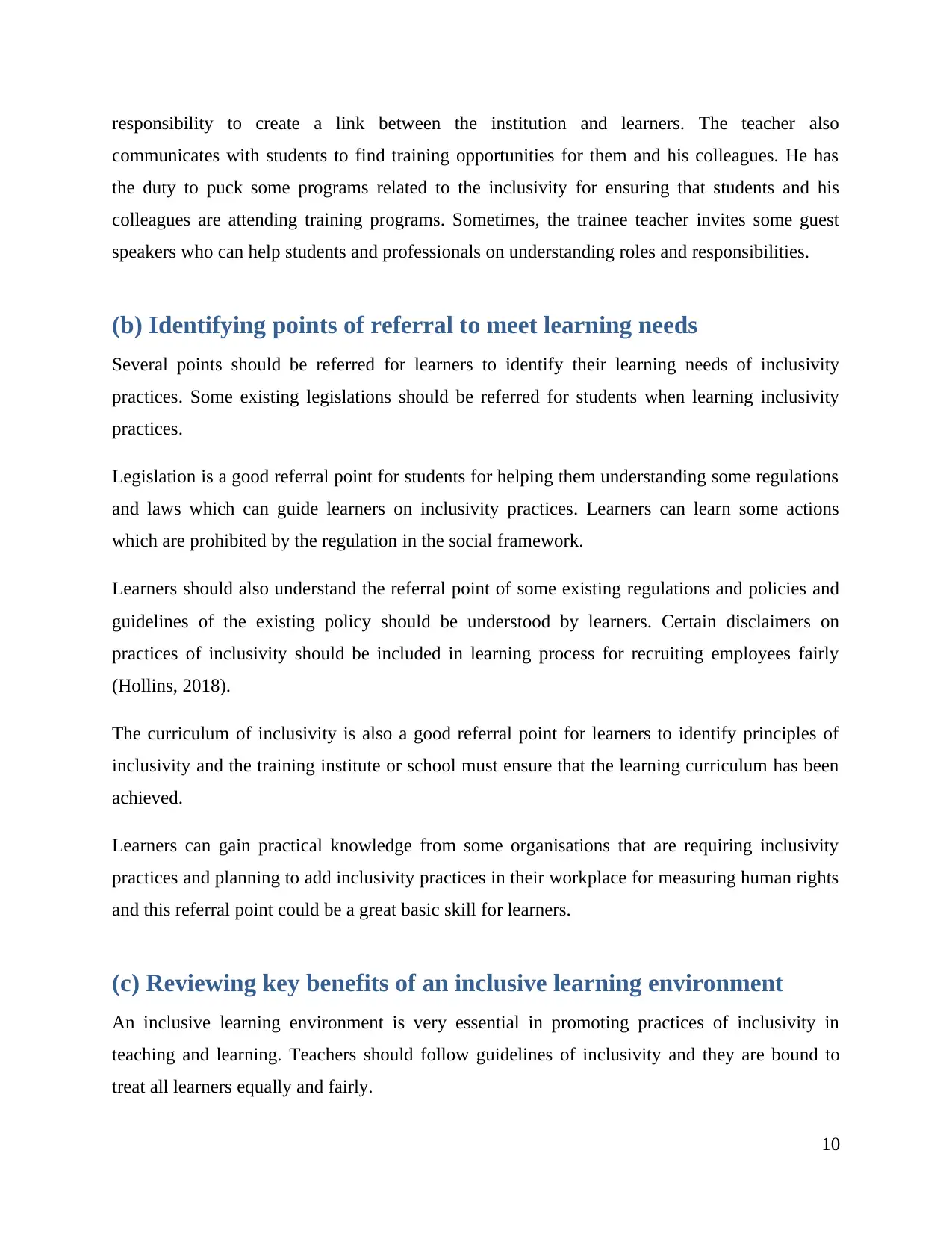
responsibility to create a link between the institution and learners. The teacher also
communicates with students to find training opportunities for them and his colleagues. He has
the duty to puck some programs related to the inclusivity for ensuring that students and his
colleagues are attending training programs. Sometimes, the trainee teacher invites some guest
speakers who can help students and professionals on understanding roles and responsibilities.
(b) Identifying points of referral to meet learning needs
Several points should be referred for learners to identify their learning needs of inclusivity
practices. Some existing legislations should be referred for students when learning inclusivity
practices.
Legislation is a good referral point for students for helping them understanding some regulations
and laws which can guide learners on inclusivity practices. Learners can learn some actions
which are prohibited by the regulation in the social framework.
Learners should also understand the referral point of some existing regulations and policies and
guidelines of the existing policy should be understood by learners. Certain disclaimers on
practices of inclusivity should be included in learning process for recruiting employees fairly
(Hollins, 2018).
The curriculum of inclusivity is also a good referral point for learners to identify principles of
inclusivity and the training institute or school must ensure that the learning curriculum has been
achieved.
Learners can gain practical knowledge from some organisations that are requiring inclusivity
practices and planning to add inclusivity practices in their workplace for measuring human rights
and this referral point could be a great basic skill for learners.
(c) Reviewing key benefits of an inclusive learning environment
An inclusive learning environment is very essential in promoting practices of inclusivity in
teaching and learning. Teachers should follow guidelines of inclusivity and they are bound to
treat all learners equally and fairly.
10
communicates with students to find training opportunities for them and his colleagues. He has
the duty to puck some programs related to the inclusivity for ensuring that students and his
colleagues are attending training programs. Sometimes, the trainee teacher invites some guest
speakers who can help students and professionals on understanding roles and responsibilities.
(b) Identifying points of referral to meet learning needs
Several points should be referred for learners to identify their learning needs of inclusivity
practices. Some existing legislations should be referred for students when learning inclusivity
practices.
Legislation is a good referral point for students for helping them understanding some regulations
and laws which can guide learners on inclusivity practices. Learners can learn some actions
which are prohibited by the regulation in the social framework.
Learners should also understand the referral point of some existing regulations and policies and
guidelines of the existing policy should be understood by learners. Certain disclaimers on
practices of inclusivity should be included in learning process for recruiting employees fairly
(Hollins, 2018).
The curriculum of inclusivity is also a good referral point for learners to identify principles of
inclusivity and the training institute or school must ensure that the learning curriculum has been
achieved.
Learners can gain practical knowledge from some organisations that are requiring inclusivity
practices and planning to add inclusivity practices in their workplace for measuring human rights
and this referral point could be a great basic skill for learners.
(c) Reviewing key benefits of an inclusive learning environment
An inclusive learning environment is very essential in promoting practices of inclusivity in
teaching and learning. Teachers should follow guidelines of inclusivity and they are bound to
treat all learners equally and fairly.
10
Paraphrase This Document
Need a fresh take? Get an instant paraphrase of this document with our AI Paraphraser
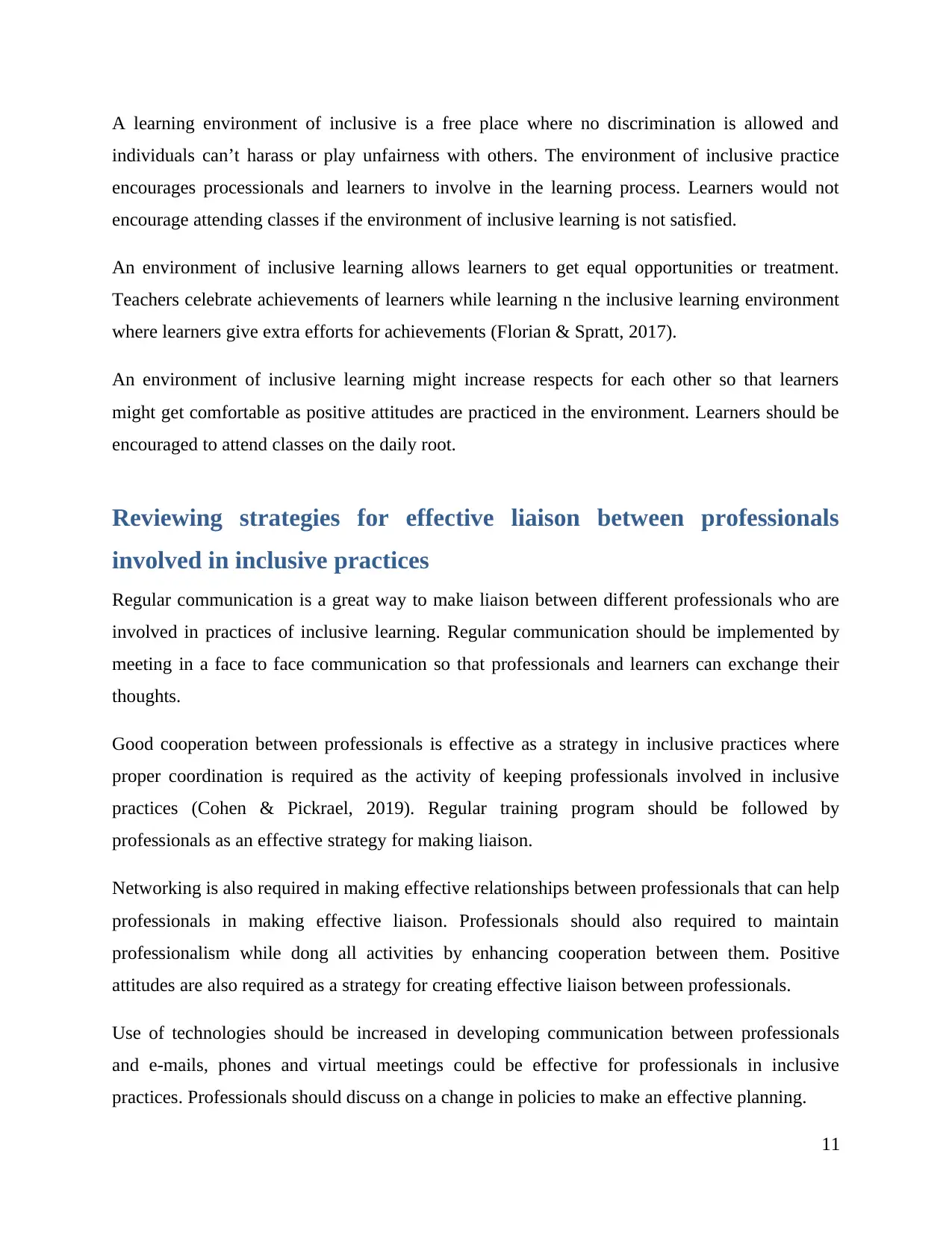
A learning environment of inclusive is a free place where no discrimination is allowed and
individuals can’t harass or play unfairness with others. The environment of inclusive practice
encourages processionals and learners to involve in the learning process. Learners would not
encourage attending classes if the environment of inclusive learning is not satisfied.
An environment of inclusive learning allows learners to get equal opportunities or treatment.
Teachers celebrate achievements of learners while learning n the inclusive learning environment
where learners give extra efforts for achievements (Florian & Spratt, 2017).
An environment of inclusive learning might increase respects for each other so that learners
might get comfortable as positive attitudes are practiced in the environment. Learners should be
encouraged to attend classes on the daily root.
Reviewing strategies for effective liaison between professionals
involved in inclusive practices
Regular communication is a great way to make liaison between different professionals who are
involved in practices of inclusive learning. Regular communication should be implemented by
meeting in a face to face communication so that professionals and learners can exchange their
thoughts.
Good cooperation between professionals is effective as a strategy in inclusive practices where
proper coordination is required as the activity of keeping professionals involved in inclusive
practices (Cohen & Pickrael, 2019). Regular training program should be followed by
professionals as an effective strategy for making liaison.
Networking is also required in making effective relationships between professionals that can help
professionals in making effective liaison. Professionals should also required to maintain
professionalism while dong all activities by enhancing cooperation between them. Positive
attitudes are also required as a strategy for creating effective liaison between professionals.
Use of technologies should be increased in developing communication between professionals
and e-mails, phones and virtual meetings could be effective for professionals in inclusive
practices. Professionals should discuss on a change in policies to make an effective planning.
11
individuals can’t harass or play unfairness with others. The environment of inclusive practice
encourages processionals and learners to involve in the learning process. Learners would not
encourage attending classes if the environment of inclusive learning is not satisfied.
An environment of inclusive learning allows learners to get equal opportunities or treatment.
Teachers celebrate achievements of learners while learning n the inclusive learning environment
where learners give extra efforts for achievements (Florian & Spratt, 2017).
An environment of inclusive learning might increase respects for each other so that learners
might get comfortable as positive attitudes are practiced in the environment. Learners should be
encouraged to attend classes on the daily root.
Reviewing strategies for effective liaison between professionals
involved in inclusive practices
Regular communication is a great way to make liaison between different professionals who are
involved in practices of inclusive learning. Regular communication should be implemented by
meeting in a face to face communication so that professionals and learners can exchange their
thoughts.
Good cooperation between professionals is effective as a strategy in inclusive practices where
proper coordination is required as the activity of keeping professionals involved in inclusive
practices (Cohen & Pickrael, 2019). Regular training program should be followed by
professionals as an effective strategy for making liaison.
Networking is also required in making effective relationships between professionals that can help
professionals in making effective liaison. Professionals should also required to maintain
professionalism while dong all activities by enhancing cooperation between them. Positive
attitudes are also required as a strategy for creating effective liaison between professionals.
Use of technologies should be increased in developing communication between professionals
and e-mails, phones and virtual meetings could be effective for professionals in inclusive
practices. Professionals should discuss on a change in policies to make an effective planning.
11

12
⊘ This is a preview!⊘
Do you want full access?
Subscribe today to unlock all pages.

Trusted by 1+ million students worldwide
1 out of 18
Related Documents
Your All-in-One AI-Powered Toolkit for Academic Success.
+13062052269
info@desklib.com
Available 24*7 on WhatsApp / Email
![[object Object]](/_next/static/media/star-bottom.7253800d.svg)
Unlock your academic potential
Copyright © 2020–2025 A2Z Services. All Rights Reserved. Developed and managed by ZUCOL.




